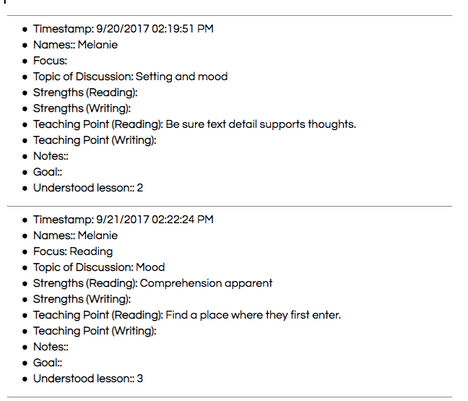
In Reading and Writing Workshop, everyone will tell you the importance of conferencing with students. What exactly is conferencing? In my definition, it is meeting one-on-one with a student about his/her reading or writing work. Then, you meet again at some point to follow-up on what was discussed prior.
A lot of people will tell you that conferencing has to be done a specific way; that you *have to* meet with each student for a specific amount of time; that you *have to* take specific types of notes, etc. etc. Your district may even enforce certain guidelines. Experience and trial and error have taught me quite a bit about the best approach to conferencing (or, at least what works for me).
Early Experiences with Conferencing
I've been at this for several years now. When I first heard about student conferencing, I loved the idea and honestly thought, well, duh, shouldn't we be doing this anyway? Then, I kept hearing about all these formal ways that it *had* to be done. It was very overwhelming.
As a novice teacher, I obviously did it exactly as I was told. I took voracious notes. I had a fancy binder. When I got my first iPad, I legit took pictures of every. single. journal response a kid made. I used Evernote to keep notes. Guess what? I never looked at any of these notes. I spent so much time compiling, noting, listing, and organizing that I never actually had time to read and reflect on those notes. Honestly, I was doing it to appease the higher-ups. They loved it, but I wasn't (and the students weren't) benefiting from it.
Eventually, I got bitter about it. I'd conference but did not take any notes. It was actually so much better because I spent so much more time with students since I didn't have to worry about the stinking notes I had to take. But, sometimes I forgot what I met with that student about the next time I'd meet with him/her.
What I Do Now
First of all, let's discuss timing. In middle school, our time is limited and precious. 15-minute conferences do NOT happen in my classroom. Most of my conferences are about 5 minutes or less. Being digital has made things a lot easier. I sometimes pull up a student's work before they come back to meet with me, look it over, then discuss.
For work with reading, I will typically pull a student back to discuss the skill they are working on right then and there. I don't go back to old skills; I don't teach new skills; I stay in the moment. A lot of times, I just ask them about what they are reading and if they like the book.
For writing, I have them come back to me for specific things. For example, I tell them to come back and conference with me after they've written a body paragraph. I'll read it over and send them on their way...then I'll say "come back after two more paragraphs".
Now, I learned I need to keep track of this somehow. Then Google Forms entered the picture. This has completely saved my record-keeping life. I messed around with different formats. I will talk about two here.
So, I have a more detailed version and a very minimal version. The one you see below lists a variety of ELA skills that I would meet about with a student. A little prep beforehand allowed me to list each student in the form. Once the student met with me, I'd simply check off the subject, topic, strengths, weaknesses, and teaching point(s). I could then go in to the Google Sheet record to refer back to my notes. You can get this Form here! There are more options to click in the link.
The Google Sheet version is a bit messy to look at sometimes, so I learned about the add-on called Doc Appender. This allows you to take all of this information from Forms and put it into Google Docs. Each student had a Doc that the Form would push out its information to. This was perfect to show admin, too! I just had to find the folder with the student's name and boom, all the information was there. (You could go on YouTube to find some videos about how to use it...here's one). Below, you will see pictures of what this looks like.

Sometimes, I have a real slimmed-down version where I just jot notes down manually. I click into the responses to see who I have to meet with next based on this.
These Forms are great when grading, too...an easy click to check progress. With Forms, too, I use these notes to grade rough drafts. If I meet with the students throughout the entire process, I don't have to reread.
I meet with every student at least 2x per writing piece. Reading is a little looser and more as-needed.

Bottom Line
We are limited with time in middle school. Google Forms saves a ton of time with conferencing. Also, consider your expectations and make them realistic. Determine what is your true purpose for meeting with students. Build your conferencing schedule around that.
If you want a conferencing Google Form for yourself, click here! This is the detailed one. The simplified version is pictured above; that one you can easily recreate for yourself!
Want a CUSTOM BUNDLE from me? Click below!
Follow me:















